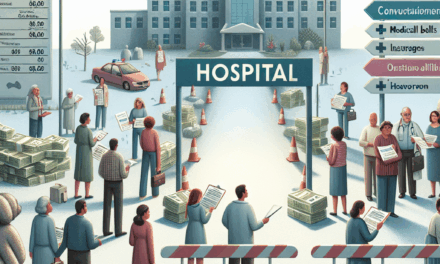Senate Moves Forward with Budget Plan Amid Medicaid Cut Concerns in Healthcare
The U.S. Senate is currently navigating a complex landscape as it moves forward with a budget plan that has raised significant concerns regarding potential cuts to Medicaid. This article delves into the implications of these budgetary decisions, the impact on healthcare services, and the broader socio-economic ramifications. With a focus on five key subtopics, we will explore the intricacies of the Senate’s budget plan, the role of Medicaid in the healthcare system, the potential consequences of cuts, alternative funding solutions, and the political dynamics at play.
The Senate’s Budget Plan: An Overview
The Senate’s budget plan is a critical component of the federal government’s fiscal strategy, aimed at addressing various economic challenges while balancing the need for essential services. The proposed budget outlines spending priorities, revenue generation strategies, and potential cuts to various programs, including Medicaid.
In recent sessions, the Senate has faced pressure to reduce the federal deficit while also addressing the rising costs of healthcare. The budget plan reflects a compromise between different political factions, with some advocating for increased funding for healthcare services and others pushing for austerity measures.
- Budget Allocation: The proposed budget allocates funds across various sectors, including defense, education, and healthcare. The healthcare sector, particularly Medicaid, is under scrutiny as lawmakers debate the necessity of cuts.
- Deficit Reduction Goals: The Senate aims to reduce the federal deficit by a specified percentage over the next few years. This goal has led to discussions about the sustainability of programs like Medicaid, which serves millions of low-income Americans.
- Political Compromise: The budget plan is a result of negotiations between Democrats and Republicans, each with differing priorities. The challenge lies in finding common ground while addressing the needs of vulnerable populations.
- Impact on States: States rely heavily on federal funding for Medicaid, and any cuts could lead to significant financial strain on state budgets, potentially resulting in reduced services or increased state taxes.
- Public Response: Advocacy groups and healthcare professionals have voiced concerns about the potential impact of Medicaid cuts on patient care, leading to public outcry and calls for a reevaluation of the budget plan.
The Role of Medicaid in the U.S. Healthcare System
Medicaid is a vital program that provides health coverage to millions of low-income individuals and families in the United States. Established in 1965, it has evolved into a cornerstone of the American healthcare system, offering essential services to those who might otherwise lack access to care.
Understanding the role of Medicaid requires an examination of its structure, funding mechanisms, and the populations it serves. Medicaid is jointly funded by the federal and state governments, with states having the flexibility to design their programs within federal guidelines.
- Eligibility Criteria: Medicaid eligibility varies by state but generally includes low-income families, pregnant women, children, elderly individuals, and people with disabilities. The expansion of Medicaid under the Affordable Care Act (ACA) has further increased enrollment.
- Comprehensive Coverage: Medicaid covers a wide range of services, including hospital visits, preventive care, mental health services, and long-term care. This comprehensive coverage is crucial for maintaining the health of vulnerable populations.
- Economic Impact: Medicaid not only provides health coverage but also stimulates local economies. By funding healthcare services, it creates jobs and supports healthcare providers, particularly in underserved areas.
- Public Health Outcomes: Studies have shown that Medicaid expansion is associated with improved health outcomes, including increased access to preventive services and reduced mortality rates among low-income populations.
- Challenges and Limitations: Despite its successes, Medicaid faces challenges such as funding shortfalls, administrative complexities, and disparities in access to care across different states.
Potential Consequences of Medicaid Cuts
The prospect of cuts to Medicaid raises serious concerns about the potential consequences for millions of Americans who rely on the program for their healthcare needs. Reductions in funding could lead to a cascade of negative outcomes, affecting not only individuals but also healthcare systems and state economies.
One of the most immediate impacts of Medicaid cuts would be a reduction in services available to beneficiaries. This could manifest in several ways:
- Increased Uninsured Rates: Cuts to Medicaid could lead to millions losing their coverage, resulting in higher uninsured rates. This would place additional strain on emergency services and increase healthcare costs for everyone.
- Access to Care: With reduced funding, states may limit the number of providers willing to accept Medicaid patients, leading to longer wait times and decreased access to necessary services.
- Health Outcomes: Research indicates that individuals without health insurance are less likely to receive preventive care and more likely to experience adverse health outcomes. Cuts to Medicaid could exacerbate these disparities.
- Economic Consequences: The economic impact of Medicaid cuts extends beyond individual health. Reduced funding can lead to job losses in the healthcare sector, decreased spending in local economies, and increased costs for state governments.
- Increased Burden on Other Programs: As Medicaid cuts lead to higher uninsured rates, other public programs, such as emergency services and charity care, may face increased demand, straining their resources.
Alternative Funding Solutions for Healthcare
As the Senate grapples with the budget plan and the potential for Medicaid cuts, it is essential to explore alternative funding solutions that can sustain healthcare services without compromising the well-being of vulnerable populations. Several innovative approaches could be considered:
- Value-Based Care Models: Transitioning to value-based care models can improve efficiency and reduce costs. By incentivizing providers to focus on patient outcomes rather than volume, healthcare systems can achieve better results with existing resources.
- Public-Private Partnerships: Collaborations between public entities and private organizations can enhance funding for healthcare initiatives. These partnerships can leverage private investment to support public health programs and expand access to care.
- Pharmaceutical Pricing Reform: Addressing high drug prices through policy reforms can free up resources for Medicaid and other healthcare programs. Implementing price negotiations and transparency measures can lead to significant savings.
- Preventive Care Investments: Investing in preventive care can reduce long-term healthcare costs. Programs that focus on wellness and disease prevention can lead to healthier populations and lower expenditures on acute care.
- Tax Reforms: Adjusting tax policies to increase funding for healthcare can provide a sustainable revenue source. This could include closing tax loopholes for corporations or increasing taxes on high-income earners to support public health initiatives.
The Political Dynamics Surrounding Medicaid Cuts
The debate over Medicaid cuts is deeply intertwined with the political landscape in the United States. As lawmakers navigate the complexities of the budget plan, various political dynamics come into play, influencing decisions and shaping public discourse.
Understanding these dynamics requires an examination of the key players involved, their motivations, and the broader implications for healthcare policy:
- Partisan Divides: The issue of Medicaid cuts often falls along partisan lines, with Republicans generally advocating for reduced government spending and Democrats emphasizing the importance of social safety nets. This divide complicates negotiations and consensus-building.
- Lobbying and Advocacy: Healthcare advocacy groups, including those representing patients, providers, and insurers, play a significant role in shaping the debate. Their lobbying efforts can influence lawmakers’ positions and public opinion.
- Public Sentiment: Public opinion on Medicaid cuts is a critical factor in the political calculus. Lawmakers must consider the potential backlash from constituents who rely on Medicaid, particularly in swing states where healthcare is a key issue.
- Election Cycles: The timing of budget decisions often coincides with election cycles, adding pressure on lawmakers to align their positions with voter preferences. This can lead to more cautious approaches to proposed cuts.
- Future of Healthcare Policy: The outcome of the current budget plan may set a precedent for future healthcare policy. How lawmakers address Medicaid cuts could influence broader discussions about healthcare reform and the role of government in providing care.
Conclusion
The Senate’s movement forward with its budget plan amid concerns over Medicaid cuts highlights the complex interplay between fiscal responsibility and the need for accessible healthcare. As lawmakers navigate this challenging landscape, the implications of their decisions will resonate across the nation, affecting millions of Americans who rely on Medicaid for their health and well-being.
Understanding the role of Medicaid, the potential consequences of cuts, and exploring alternative funding solutions is crucial for informed public discourse. Additionally, recognizing the political dynamics at play can help stakeholders advocate for policies that prioritize the health of vulnerable populations while addressing fiscal challenges.
As the debate continues, it is essential for citizens, healthcare professionals, and policymakers to engage in constructive dialogue, ensuring that the needs of those who depend on Medicaid are not overlooked in the pursuit of budgetary goals. The future of healthcare in America hinges on finding a balance between fiscal prudence and the moral imperative to provide care for all.





